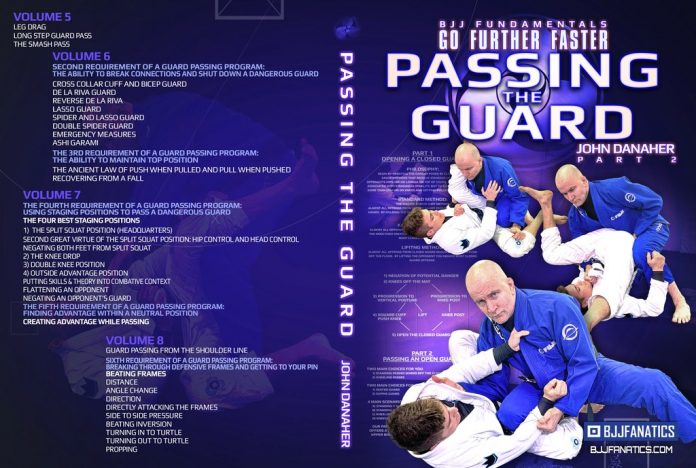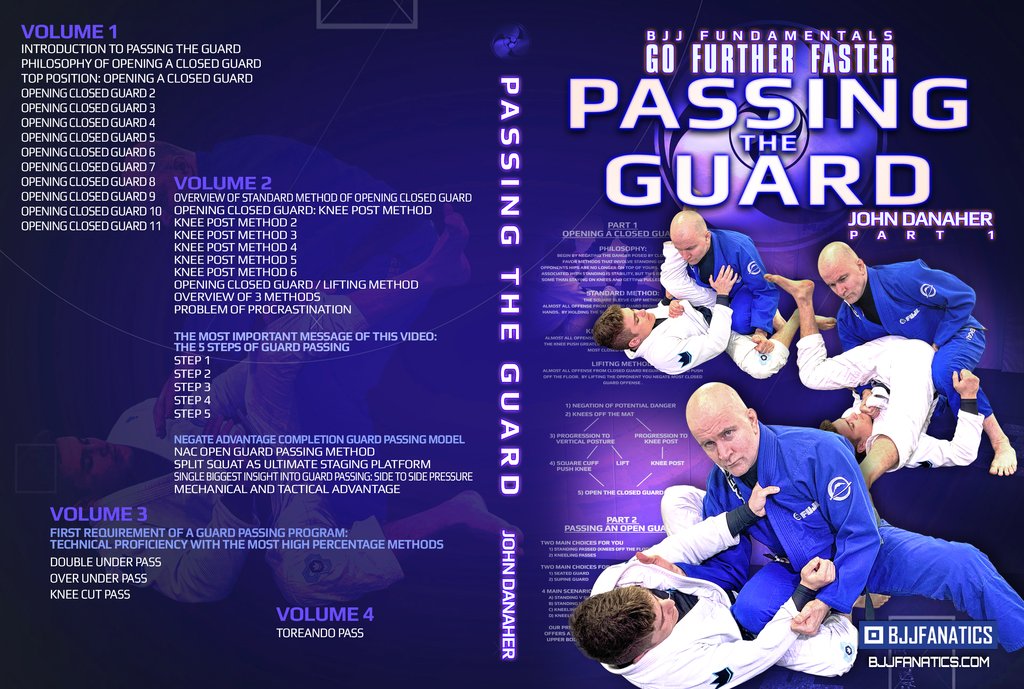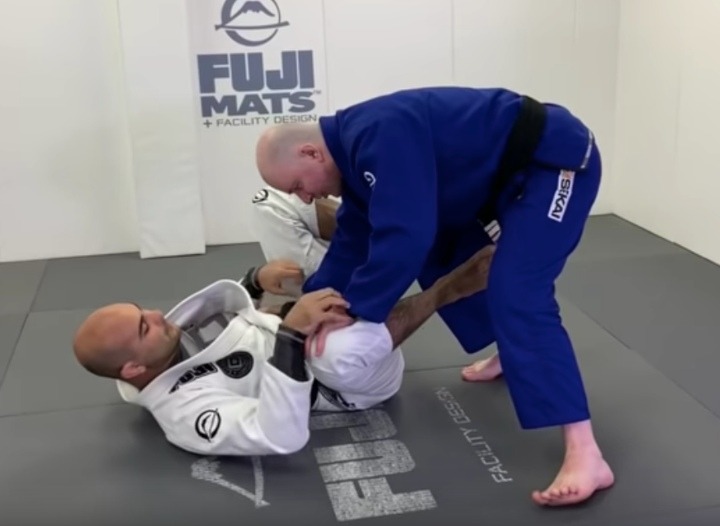
I love leg locks and front headlocks just like the next BJJ guy or girl, perhaps even more. However, I have been waiting for a John Danaher DVD on passing the guard ever since he first started issuing them. Of course, there was none of it in his submission orientated No-Gi series. In the Gi series that is still not complete, Danaher certainly took his time delivering on such an instructional, That said, the Go Further Faster: Passing the Guard Danaher DVD Instructional went live yesterday, which is long overdue. Luckily I had the chance to sneak a peek earlier for a review.
ON SALE HERE:
John Danaher – Passing The Guard

Gi or No-Gi, you can’t argue that John Danaher’s methods work. He is weird and unusual in his approach but the results of his students speak volumes. It is not just Gordon Ryan – every grappler who has dedicated to training full-time with Danaher has achieved incredible results. His systems work, as long as you have the patience to study them. As usual, this Passing the Guard Danaher DVD instructional is a 10hour long, 8-volume set that will have you occupied for months. What you’ll get in return though is a foolproof formula for passing any guard that any opponent decides to play against you. I’ve only gone through the entire DVD once, but I’d go as far as calling it Danaher’s most groundbreaking one yet.
Go Further Faster Series – DVD Number Six
I have to admit, I’m not fully immersed in the Go Further Faster series yet. I’ve seen them all, of course, but it did take me by surprise that we’re up to the sixth DVD of the system. Not complaining, of course, but that just means there’s a lot of catching up for me to do once I decide to brush up on my Gi skills. That said, I’m certainly making an exception with the guard passing one.
So far, Danaher has DVDs out on the closed guard, open guard, half guard, and guard retention. He also has a crazy good instructional on how to escape pins and the turtle position. In other words, he covered pretty much every subject when it comes to staying safe and launching attacks from the bottom. So far, though, there hasn’t been anything regarding top positions. Let’s hope that the new Passing The Guard Danaher DVD Instructional will serve as the starting point for more of his future DVDs that will explore and explain how the top game of Jiu-Jitsu is played, DDS-style.
The one thing that I can attest is entirely true about Danaher’s Go Further Faster Series is that it really lives up to its name. If you want to learn BJJ fast, this is the series to get. It will take you time to go through it all, but what you’ll discover is that you become an expert in certain fields of Jiu-Jitsu much faster than your peers. I’m seeing this happen in the academy over and over again, with those that follow the DVDs step by step showing the most impressive results. Currently, I’m taking this brand new guard passing one for a test drive, and I’m loving it!
The Curious Subject Of Passing Guard in BJJ
Guard passing is one of those skills that nobody can teach you. Yes, I really mean that. There’s a reason why every black belt has a different game when it comes to passing the guard. Everyone discovers their own formula that leads to success. Usually, solving the guard passing puzzle has to do with understanding guards and finding a rhythm that best suits you to disengage and pass them. The real challenge, though, is not passing a guard once you develop a system. It is teaching it to others in a successful manner that truly sets a guard pass or a system of passes aside from all the others.
So far, not many professors, instructors, coaches, call them however you want, have been able to truly convey their guard passing skillsets to as many people s possible. At least not with a success rate at the highest levels. We all know Danaher doesn’t fit this mold, as he’s proven over and over again. However, I had to admit, I was curious as to how he will approach a tricky subject like this. After all, the goal is not just to figure out a guard passing formula that you can pick up fast, but also one that works at the highest levels of the sport, as Danaher often likes to say.
AS I said, I still need to really get a grasp on even the most basic of principles outlined by John. However, If early indications are anything to judge by, we finally might have a solution forth e guard passing puzzle of BJJ. And it is one that you can apply not just to any guard in existence, but also any new guard that might spring up in the future.
Passing The Guard Danaher DVD Instructional Chapter-by-Chapter Review
A John Danaher DVD Instructional has two main characteristics. First, it is longer, and better organized than any other BJJ DVD you might come across. Secondly, it contains information that you’ll find nowhere else. I’ve seen every minute of every Danaher DVD so far, and I can attest to these two things being ever-present in each of them.
The latest Passing The Guard Danaher DVD Instructional checks all these boxes, as expected. It is organized in 8 volumes, starting, of course, with the philosophy of guard passing, mostly regarding the closed guard. A lot of attention goes to positioning and base, as well as the steps that make up a guard pass. Technical details on all of the highest percentage passes follow, covering the Torreando, double and single underpass, knee slice, leg drags, smash pass, etc. All of that falls under the first requirement of guard passing. From there on, Danaher covers 5 more requirements that are certain to get you past anyone’s legs, as long as you follow them correctly.
Part 1 – Closed Guard Passing Philosophy
Opening this Passing the Guard Danaher DVD Instructional is the mandatory introduction to the entire set. I’d suggest you pay close attention to the second chapter, which outlines Danaher’s innovative guard passing philosophy in detail. It will make instant sense, and you’ll wonder why you haven’t thought of some things in that manner before.
The technical focus of this portion, sort of speak, is on the closed guard. Beginning inside someone’s closed guard, Danaher offers his insights into what the top position is all about in this case. He moves on to cover the ins and outs of opening a closed guard, before offering a staggering 12 options to open up anyone’s guard. Suffice to say, I wish I had a cess to all of this knowledge when I was a white/blue belt struggling with the closed guard. Better late than never, though!
Part 2 – The 5 Steps Of Guard Passing
The second volume stays on the track of opening the closed guard. Here, John covers the so-called “standard” method of opening (from the knees). He also clears up the Knee post method, something we’ve all been doing incorrectly, as it turns out. In fact, almost half of this part is all about the knee post method. The lifting method wraps up the closed guard portion, but not before Danaher shares and ultra-interesting concept on procrastinating when passing the guard.
What Danaher himself addresses as the most important message in this DVD, which is Danaher’s groundbreaking 5-step formula for getting past any and all guards. After watching it, I completely agree. I have my own guard passing “understanding” but I have to admit, this 5-step formula makes everything so much better.
Wrapping up si yeat another interesting 4-chapter section covering the Negate Advantage Completion guard passing model. As the name suggests, it is elaborate and complex but makes all the sense in the world. Part two ends with notes on mechanical and tactical advantages.
Part 3 – First Requirement Of Guard Passing
Here’s where this Passing The Guard Danaher DVD instructional really gets interesting. The first requirement, according to John is having a sufficient technical proficiency in guard passing methods. In that sense, he chose the ones that are by far the highest percentage passes in the history of the sport.
The DVD kicks things off with an explanation of the double underpass, in a way you haven’t seen before. And yes, that includes Gordon Ryan’s way of doing it in his own instructional. On the same subject, Danaher also covers the over under pass as well, again, with an understanding that even Bernardo Faria would be jealous of. The knee cut pass also gets attention here, with a special mention of how Danaher sets up in base when executing it.
Part 4 – The Torreando
Unusually for John Danaher, the fourth volume has just one chapter – the Torreando guard. No elaborate principles and mind maps, just one simple chapter. However, watching this particular part of Danaher’s DVD is a real experience like you’ve never had before. The Toreando is anything but simple, but it can be categorized and executed systematically. This Danaher DVD instructional will show you exactly how.
Part 5 – Drag, Step And Smash
The trio of passes that pretty much defines the modern Jiu-Jitsu top game – the leg drag, long step and smash pass. These all fit in together into a mini-system of their own. I’m a leg drag person myself, so this portion of the Passing The Guard Danaher DVD instructional really came as a gift to me. The details there are mesmerizing. The same holds true for the other two passes, especially the long step.
This trio completes Danaher’s take on the first requirement for passing any guard out there. There are seven passes in total that John considers as the first requirement to building any kind of a sustainable and high-level guard passing system.
Part 6 – Second & Third Requirements Of Guard Passing
Part 6 and 7 each feature two of the guard passing requirements of Danaher’s system. This is where everything starts to make sense. So far, Danaher covered things from a technical perspective, demonstrating guard passes and sharing the 5 steps that make a successful pass. From here on, it is more about core concepts and principles that really make passing make sense.

The third requirement has to do with the ability to maintain top position. You won’t pass many guards if you end up going to the ground, despite the possibility of getting leg locks that way. But that, as Danaher says, is an emergency measure. The principle is simple – push when pulled and pull when pushed. A key chapter on recovering from a fall (which his not the same thing as a sweep) wraps this part up.
Part 7 – Fourth & Fifth Requirements Of Guard Passing
Now that technical foundation, ways to shut down guards and top positions are no longer mysteries, it is time to explore staging positions. This is truly a magnificent concept that you can actually apply throughout BJJ, not just in guard passing. It involves the best positions you can use to start a guard pass from, particularly against dangerous guards. The positions include the split squat, knee drop, double knee and outside advantage positions. Setting yourself in one of these will immensely increase your chances of completing a pass.
The fifth requirement is something that I guess will take more time than anything. It is one of those concepts that requires not only practicing, but trying in rolling as well. The idea is that you should be finding advantages that lead to passes every time you’re in a neutral position. Innovative, logical and something I’m yet to give a try. I guess it’ll take some time.
Part 8 – The Final Requirement
Wrapping this Passing The Guard Danaher DVD Instructional up is the sixth and final passing requirement. It takes place after you pass the legs and you’re up against the final defensive layer – guard recovery. This usually involves the opponent using frames f different varieties while attempting to recover guard. In other words, this is the DVD on beating frames you’ve always wanted but never really got.
Once again, this is a full-blown, typical Danaher volume full of nothing but principles. However, presenting them at the very end ties everything together in a very logical manner. Everything you’ll ever need to know about angles, direction, pressure, dealing with inversions and turtled up opponents is right here. Out of all the volumes, this one is my favorite by far.
In Summary
As I said, we’ve come to expect a lot from a Danaher DVD Instructional. He never stops delivering and did it once again with this Passing The Guard Danaher DVD instructional. I guess we can call one of the most difficult subjects of BJJ resolved, given the amount of information and perfectly structured system in the instructional. As far as I am concerned, I noticed changes in the way I approach guard immediately. It’ll take a lot more test driving, but I have a feeling this system is here to stay. Time to see what guards will be born now, in an attempt to beat this crazy new system.
ON SALE HERE:
John Danaher – Passing The Guard



![Darce Choke Encyclopedia – Origins, Mechanics and Variations [2025] BJJ, choke, Brabo, BJJ Darce Choke, D'arce Choke, Darce BJJ Choke](https://bjj-world.com/wp-content/uploads/2017/11/JungPoirierLeeYahoo-218x150.jpg)









![No-Gi Grapplers Guide To Front Headlock Joel Bane DVD Review [2025] No-Gi Grapplers Guide To Front Headlock Joel Bane DVD Review](https://bjj-world.com/wp-content/uploads/2025/03/no-gi-front-headlock-joel-bane-dvd-review-218x150.png)

![Get Off My Legs Gringo Craig Jones DVD Review [2025] Get Off My Legs Gringo Craig Jones DVD Review](https://bjj-world.com/wp-content/uploads/2025/03/get-off-my-legs-gringo-craig-jones-dvd-review-218x150.png)

![Leg Lock Entries Helena Crevar DVD Review [2025] Leg Lock Entries Helena Crevar DVD Review](https://bjj-world.com/wp-content/uploads/2025/03/leg-lock-entries-helena-crevar-dvd-review-218x150.png)
![Special K Guard Neil Melanson DVD Review [2025] Special K Guard Neil Melanson DVD Review](https://bjj-world.com/wp-content/uploads/2025/03/special-k-guard-neil-melanson-dvd-review-218x150.png)

![Shin to Shin Eoghan O’Flanagan DVD Review [2025] Shin to Shin Eoghan O'Flanagan DVD Review](https://bjj-world.com/wp-content/uploads/2024/12/shin-to-shin-eoghan-oflanagan-dvd-review-100x70.png)
![How To Knee Cut Junny Ocasio BJJ DVD Review [2025] How To Knee Cut Junny Ocasio BJJ DVD Review](https://bjj-world.com/wp-content/uploads/2025/02/how-to-knee-cut-junny-ocasio-bjj-dvd-review-100x70.png)

![Wrestling For Jiu-Jitsu Shawn Williams DVD Review [2025] Wrestling For Jiu-Jitsu Shawn Williams DVD Review](https://bjj-world.com/wp-content/uploads/2025/01/wrestling-for-jiu-jitsu-shawn-williams-dvd-review-100x70.png)

![Gracie Secrets Closed Guard Kyra Gracie DVD Review [2024] Gracie Secrets Closed Guard Kyra Gracie DVD Review](https://bjj-world.com/wp-content/uploads/2024/12/closed-guard-kyra-gracie-dvd-review-100x70.png)
![Reverse Arm Bar System Andrew Kerfoot DVD Review [2024] Reverse Arm Bar System Andrew Kerfoot DVD Review](https://bjj-world.com/wp-content/uploads/2024/10/reverse-arm-bar-system-andrew-kerfoot-dvd-review-100x70.png)
![Slay The Wrestle Up Guard Nick Rodriguez DVD Review [2024] Slay The Wrestle Up Guard Nick Rodriguez DVD Review](https://bjj-world.com/wp-content/uploads/2024/12/slay-the-wrestle-up-guard-nick-rodriguez-dvd-review-100x70.png)
![Jeff Glover Deep Half Revolution DVD Bundle Review [2024] Jeff Glover Deep Half Revolution DVD Bundle Review](https://bjj-world.com/wp-content/uploads/2024/10/jeff-glover-deep-half-revolution-dvd-bundle-review-100x70.png)

![Arm Bar It All Shawn Melanson DVD Review [2025] Arm Bar It All Shawn Melanson DVD Review](https://bjj-world.com/wp-content/uploads/2025/03/arm-bar-it-all-shawn-melanson-dvd-review-100x70.png)
![The Stack Pass Andre Galvao DVD Review [2025] The Stack Pass Andre Galvao DVD Review](https://bjj-world.com/wp-content/uploads/2025/01/the-stack-pass-andre-galvao-dvd-review-100x70.png)



![Countering Triangles And Omoplatas Adam Mazin DVD Review [2024] Countering Triangles And Omoplatas Adam Mazin DVD Review](https://bjj-world.com/wp-content/uploads/2024/10/countering-triangles-and-omoplatas-adam-mazin-dvd-REVIEW-100x70.png)



![Kill The Underhook Dima Murovanni DVD Review [2024] Kill The Underhook Dima Murovanni DVD Review](https://bjj-world.com/wp-content/uploads/2024/10/kill-the-underhook-dima-murovanni-dvd-review-100x70.png)
![Creating Back Exposure Luke Griffith DVD Review [2025] Creating Back Exposure Luke Griffith DVD Review](https://bjj-world.com/wp-content/uploads/2025/01/creating-back-exposure-luke-griffith-dvd-review-100x70.png)

![Closed Guard Reintroduced Adam Wardzinski DVD Review [2025] Closed Guard Reintroduced Adam Wardzinski DVD Review](https://bjj-world.com/wp-content/uploads/2025/01/closed-guard-reintroduced-adam-wardzinski-dvd-review-100x70.png)

![Advanced Chin Control Concepts David Petrone DVD Review [2025] Advanced Chin Control Concepts David Petrone DVD Review](https://bjj-world.com/wp-content/uploads/2025/01/chin-control-concepts-david-petrone-dvd-review-100x70.png)
![Shotgun Aoki Locks Mateusz Szczecinski DVD Review [2025] Shotgun Aoki Locks Mateusz Szczecinski DVD Review](https://bjj-world.com/wp-content/uploads/2025/03/shotgun-aoki-locks-mateusz-szczecinski-dvd-review-100x70.png)
![Bricks Kesa Gatame System Jeremy Brick DVD Review [2025] Bricks Kesa Gatame System Jeremy Brick DVD Review](https://bjj-world.com/wp-content/uploads/2025/02/bricks-kesa-gatame-system-jeremy-brick-dvd-review-100x70.png)

